
In 1997, the Cassini probe left Cape Canaveral for space. The largest and heaviest of NASA probes, Cassini has already surveyed Jupiter sending back incredible still and animated images of that planet. The Cassini spacecraft, with its large high gain antenna, was capable of returning much more information on the Jupiter system than the previous Galileo spacecraft. Cassini moved through the Jupiter system while Galileo was still operational, making for a truly historic event in which both spacecraft made simultaneous observations of the Jovian atmosphere, rings and satellites.
|
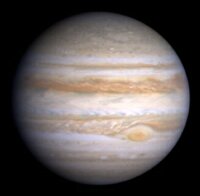
|
After Cassini's encounter with Jupiter and its rendezvous with Galileo ended in the spring of 2001, scientists had amassed the most comprehensive set of data and photos on the Jupiter system ever collected. The Cassini space probe then continued outward in the solar system, entering orbit around Saturn in 2004.
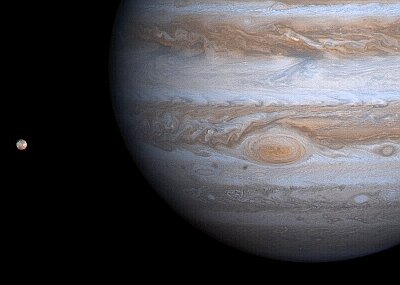 Unlike Earth, where only water condenses to form clouds, Jupiter has several cloud-forming substances in its atmosphere. The updrafts and downdrafts bring different mixtures of these substances up from below, leading to clouds of different colors. Everything visible on the planet is a cloud. The bluish areas are regions devoid of clouds and covered by high haze. The Great Red Spot is a giant storm about 2 Earths across, and over 300 years old, with winds of 300 miles per hour. The small very white features are lightning storms.
Unlike Earth, where only water condenses to form clouds, Jupiter has several cloud-forming substances in its atmosphere. The updrafts and downdrafts bring different mixtures of these substances up from below, leading to clouds of different colors. Everything visible on the planet is a cloud. The bluish areas are regions devoid of clouds and covered by high haze. The Great Red Spot is a giant storm about 2 Earths across, and over 300 years old, with winds of 300 miles per hour. The small very white features are lightning storms.
In this picture above, Jupiter's closest moon, Io, is visible. The white and reddish colors on Io's surface are due to the presence of different sulfurous materials, while the black areas are due to silicate rocks. Like the other Galilean satellites, Io always keeps the same side facing Jupiter. Io has more than 100 active volcanoes spewing lava at extemely high temperatures, and giant plumes of gas and dust rising up to 400 km high.
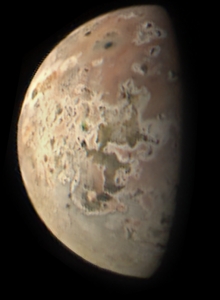
NASA's Juno spacecraft has been in orbit around Jupiter, and passed by its moon Io in 2023. Io is a place teeming with volcanoes and lava.
Over the coming year, Juno will pass even closer to Io, ultimately traveling within 1,500 kilometers of its surface.
Observers on Io, working in the dark, would be surrounded by glowing, hot lava on Io's surface, and would be amazed by the colourful auroral displays in its atmosphere as Io passes through Jupiter's strong magnetic field. There would also be dramatic lightning flashes in the giant thunderstorms of Jupiter.
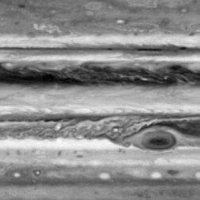
|
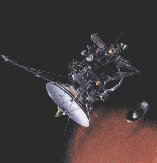 Meanwhile, as Cassini got closer to Jupiter, details not seen before became obvious. The Red Spot revealed its internal structure. This region has changed over the years, part of a general brightening of Jupiter's cloud features. The equatorial zone on Jupiter was bright white, indicating clouds much like cirrus clouds on Earth, but made of ammonia instead of water ice. This was very different from Jupiter's appearance decades before that, when the equatorial zone was brown. Meanwhile, as Cassini got closer to Jupiter, details not seen before became obvious. The Red Spot revealed its internal structure. This region has changed over the years, part of a general brightening of Jupiter's cloud features. The equatorial zone on Jupiter was bright white, indicating clouds much like cirrus clouds on Earth, but made of ammonia instead of water ice. This was very different from Jupiter's appearance decades before that, when the equatorial zone was brown.
|
Cassini also visited Titan, a moon of Saturn, in 2004. Find out more here.
Visit the University of Arizona at http://ciclops.lpl.arizona.edu/ for more pictures and information.
See how Cassini went out in a blaze of glory: Cassini's Grand Finale
Back to Jupiter/Juno page
|




 Meanwhile, as Cassini got closer to Jupiter, details not seen before became obvious. The Red Spot revealed its internal structure. This region has changed over the years, part of a general brightening of Jupiter's cloud features. The equatorial zone on Jupiter was bright white, indicating clouds much like cirrus clouds on Earth, but made of ammonia instead of water ice. This was very different from Jupiter's appearance decades before that, when the equatorial zone was brown.
Meanwhile, as Cassini got closer to Jupiter, details not seen before became obvious. The Red Spot revealed its internal structure. This region has changed over the years, part of a general brightening of Jupiter's cloud features. The equatorial zone on Jupiter was bright white, indicating clouds much like cirrus clouds on Earth, but made of ammonia instead of water ice. This was very different from Jupiter's appearance decades before that, when the equatorial zone was brown.